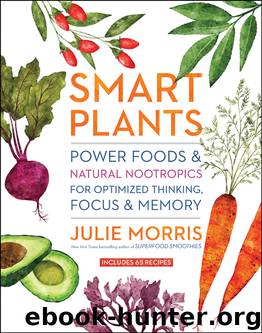Smart Plants: Power Foods & Natural Nootropics for Optimized Thinking, Focus & Memory by Julie Morris

Author:Julie Morris
Language: eng
Format: epub
Be Careful with Dopamine Precursors
Mucuna pruriens is a great example of a plant that can effectively increase dopamine levels in your brain (which explains why it is often marketed as a nootropic). This plant, also known as “velvet bean,” contains unusually large quantities of naturally-occurring L-Dopa—the direct precursor of dopamine—with levels as high as 9 percent potency (and even higher in concentrated formulas). Mucuna pruriens also enhances lucid dreaming and sex drive, which makes it easy to see why it’s such a sought-after “superfood.” However, caution is advised.
Thanks to the nutrients they contain, most brain-boosting foods can help optimize how you process dopamine. But these nutrients have many other uses in the body as well. For example, the amino acid tyrosine, which your body can convert into L-Dopa if needed, can also be used for many other functions, such as making thyroid hormones. But foods containing L-Dopa signal just one thing to your brain: Produce more dopamine! Make no mistake: This direct impact on neurotransmitters is essentially self-medication, and it comes with great risk. You really don’t want to go out of your way to disrupt dopamine balance, which can have a dangerous domino effect on your mental microclimate.
So while Mucuna pruriens can be helpful in cases of Parkinson’s, where dopamine is compromised, it doesn’t mean it’s good for someone who is healthy. In that light, it would be wise to steer clear of taking L-Dopa-rich ingredients, like Mucuna pruriens, on a regular basis. When I asked Dr. Andrew Hill (the cognitive neuroscientist and creator of the Peak Brain Institute, with whom I spoke at the beginning of my own brain optimization journey) about “velvet bean,” he looked me straight in the eye and said, “I’d be very careful with this one.” Given the long list of potential side effects caused by L-Dopa (or too much dopamine), I’m inclined to agree and would therefore not rely on the foods that contain it as nootropics.
Fortunately, L-Dopa is naturally found in very few edibles, other than tamarind (probably the most common natural source, albeit much less potent than Mucuna pruriens) and a few rarely used herbs, including senna and moth bean. Outside of its medical uses to treat people suffering from diseases or those in a catatonic state, it’s probably not something you want to actively seek out on your own.
Download
This site does not store any files on its server. We only index and link to content provided by other sites. Please contact the content providers to delete copyright contents if any and email us, we'll remove relevant links or contents immediately.
Periodization Training for Sports by Tudor Bompa(8210)
Why We Sleep: Unlocking the Power of Sleep and Dreams by Matthew Walker(6654)
Paper Towns by Green John(5136)
The Immortal Life of Henrietta Lacks by Rebecca Skloot(4548)
The Sports Rules Book by Human Kinetics(4342)
Dynamic Alignment Through Imagery by Eric Franklin(4176)
ACSM's Complete Guide to Fitness & Health by ACSM(4019)
Kaplan MCAT Organic Chemistry Review: Created for MCAT 2015 (Kaplan Test Prep) by Kaplan(3970)
Introduction to Kinesiology by Shirl J. Hoffman(3743)
Livewired by David Eagleman(3729)
The Death of the Heart by Elizabeth Bowen(3578)
The River of Consciousness by Oliver Sacks(3572)
Alchemy and Alchemists by C. J. S. Thompson(3481)
Bad Pharma by Ben Goldacre(3396)
Descartes' Error by Antonio Damasio(3247)
The Emperor of All Maladies: A Biography of Cancer by Siddhartha Mukherjee(3112)
The Gene: An Intimate History by Siddhartha Mukherjee(3074)
The Fate of Rome: Climate, Disease, and the End of an Empire (The Princeton History of the Ancient World) by Kyle Harper(3030)
Kaplan MCAT Behavioral Sciences Review: Created for MCAT 2015 (Kaplan Test Prep) by Kaplan(2957)
